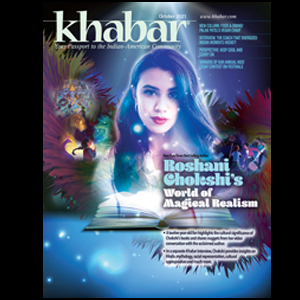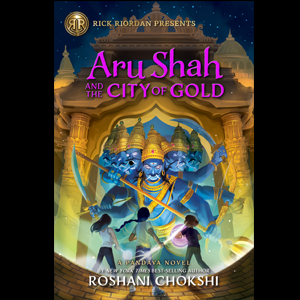Forum: Mythology: Retaining Respect vs Celebrating Feminism

In response to our October cover story, “Roshani Chokshi’s World of Magical Realism,” Dr. BHAGIRATH MAJMUDAR, while appreciating Chokshi’s work, also raises thought-provoking questions about the wisdom of taking liberties with sacred mythologies.
Kudos to Roshani Chokshi for her celebrated authorship that has enriched children’s literature. We do need to engage our younger generation in reading creative and imaginative books that gifted authors like Chokshi conjure up.
At the same time, I have a few questions that have arisen from reading her book, Aru Shah and the City of Gold.
Unlike fantasy fiction such as Harry Potter or the Percy Jackson series, Indian mythology is interwoven with religion—and that makes it sacrosanct. These timeless stories may not have a documented history, but they are transmitted through the generations and are ingrained in our ethos. These mythologies may well be more than real—as propounded by Joseph Campbell, a nationally known champion of the power of mythology in preserving culture and laying a moral foundation of the society. Many of India’s spiritual heroes have evolved drinking from the depths of Ramayana and Mahabharata. These sacred tomes have unfailingly nourished the faith of the people of the Indian sub- continent for thousands of years.
As such, they need to be assiduously guarded against random alterations.
The author has created in this book a crafty quilt, but one that also raises questions. Hanuman and Urvashi cannot be juxtaposed because they cannot be chronologically aligned. It is like placing together Christ and Cleopatra on the same podium. Such a somersault may be amusing, but also discomfiting because its
instinctive originality comes at the expense of piety.
One is fully entitled to evaluate our mythology, comment on it, criticize it, and even invalidate it… but we cannot alter it at our will. It is not needed to recast Pandavas as women just to prove the valor of women. Our mythology is full of examples of the power of the feminine. In Ramayana, Kaikeyi accompanies her husband Dasharath to the battlefield to fight a war. Mother Goddess Kali puts a resolute end to many powerful demons. Arjun plays the role of a woman for one year as Brihannalata. The author had ample opportunity for making a case for feminism without resorting to an imaginary recasting of Pandavas as females. It appeared to me as though she had mixed together immiscible oils and waters from Arabian Nights, Alice in Wonderland, and her hitherto lived western life.
Since she was so mature and forthright in answering the questions in her interview, I wonder if she consulted scholars of Indian mythology besides the western ones. If playing with Abrahamic religions elicits a tumultuous response, we must employ some safeguards to protect our Indian heritage also. We must also admit our own failure in educating our children about our heritage in a more systematic way. Learning our mythology from senior members of the family may be a good first step but not the last one.
This does not mean that we shouldn’t relax our rules to accommodate different creative interpretations of our mythology. The character of Rama in Raghuvansham by Kalidas and in Uttararamacharitam by Bhavbhuti are diametrically opposite, illustrating a sophisticated artwork. Art, when disciplined, produces phenomenal outcomes.
I hope the author, with her promising career, guards our profoundly precious heritage. This will become immediately imperative should this book turn into a movie production, especially with the media often distorting our history and culture.
Finally, I want to express my deep pride in what the author has done so far with brilliance and originality. I don’t mean to be harsh in my critique but would like to encourage her in further exploring the gold mine of our ancient wisdom.
Dr. Bhagirath Majmudar, a retired Emeritus Professor of Pathology and Obstetrics-Gynecology, Emory University, is also a Sanskrit Visharada and Jagannath scholar, the highest academic honor in Sanskrit. As a Hindu priest, he has conducted about 400 weddings, many of them interfaith. He is a poet, philosopher, Vedantist, actor and playwright. He can be reached at: bmajmud1962@gmail.com.
Celebrating the Feminine Through Our Mythology
A healthy reinterpretation of our sacred mythology to make it more accessible and meaningful for contemporary young readers, far from diminishing it, enhances its vitality, responds ROSHANI CHOKSHI.
Thank you so much, Dr. Bhagirath Majmudar, for your thoughtful questions. I was tickled you found Aru Shah and The City of Gold “a crafty quilt!” It made me daydream about a sentient blanket admiring its own embroidery, which is always good fodder for inspiration.
I noticed you referenced book four in a five-book series. I think starting from the beginning of the series with Aru Shah and The End of Time may have been helpful, considering that the Author’s Note answers much of what you’ve raised.

Sure, reimagining the Pandavas as women is not “needful,” but the absence of need does not necessarily implicate harm. If anything, engaging with the ancient celebrates its vitality and accessibility throughout the ages. In changing the Pandavas’ sex, I drew from well-documented inspiration in the figures of Shikhandi, Mohini, Budh Graha and Ardhanarishvara. Your examples of courageous women are some of my favorite figures. Giving female characters—such as Surparnakha, Tara, Uloopi, and more—ample page space has been one of my great joys in writing this series.
The idea that my art and piety are in contention was curious. To me, art is an act of devotion. I practiced bharatnatyam for ten years and though it ruined my knees, it reminded me that the expression of the sacred is not a fixed choreography. Growing up, my parents exposed me to differing faiths. We went to Hindu temple and attended church with our Catholic, Filipino mother. Even as my husband and I consider ourselves practicing Hindus, my parents gifted us with a nuanced understanding of the sacred. Where I draw my lines of piety can—and should—differ from others. To ask Aru Shah to reflect—or guard—every Hindu experience furthers the harmful stereotype that people of color are a monolith when we contain a multiverse of emotion and experience.
Surprisingly, I did not consult with any scholars—western or otherwise—in writing the Aru Shah series. The final book, however, was an exception and led to a wonderful exchange with Vineet Chandar, Hindu chaplain at Princeton University, in discussing modern interpretations of the Gita. In truth, the entirety of my research involved the joyful haranguing of my grandparents over FaceTime and asking my aunts, “Do you remember that one time you told me that story and I had nightmares for a week…” This is reflective of my diasporic experience. For many of us who were born here, exposure to our heritages depends on those who came before us. You make a wonderful point that learning from our family is a good first step, but not a last one. It was always my hope—and one that has been expressed in the pages of Aru Shah—that the readers’ line of inquiry does not stop with my last page.
I’m delighted by the questions you’ve raised because they underscore why I wrote Aru Shah in the first place. I wrote this because growing up, I had nothing else to reach for, no world where I saw myself. We live in exciting times where fantastical tales do not solely drink from Greco-Roman roots. These questions are necessary growing pains for exploration, and I welcome them because it proves that we need so much more than what we have. My greatest hope is that Aru Shah will inspire works that continue to expand, interrogate and reflect on all of our experiences. Thank you for eloquently illuminating the need for such nuance.
Roshani Chokshi is the critically acclaimed author of several New York Times bestselling series including The Star-Touched Queen duology, The Gilded Wolves trilogy, and the Pandava series, which Time Magazine named “100 Best Fantasy Books of All Time.”
Enjoyed reading Khabar magazine? Subscribe to Khabar and get a full digital copy of this Indian-American community magazine.
blog comments powered by Disqus










